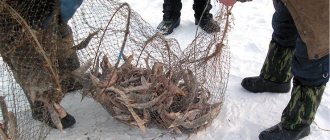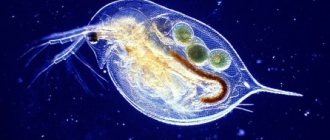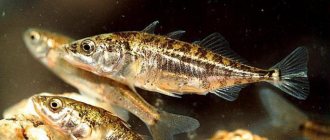Lat. Salamandra salamandra
The fire salamander is a species of tailed amphibian with a body shape resembling a lizard, with bright colors and poisonous glands.
| Squad - tailed | Family - salamanders | Genus : salamanders |
| Habitat : Europe |
| Habitat – forests, fields, rocks, some subspecies live in aquatic environments |
| Length – up to 20 cm |
| Weight – about 100 grams |
| Reproduction method : viviparous |
| Number of cubs – 8—70 |
| Venom – a strong toxic venom in the parotid glands behind the eyes |
| Life expectancy – about 20 years |
| Protected status – least threatened |
Appearance
They can differ greatly in both appearance and behavior. There are several subspecies and their intermediate forms, which have significant differences.
Most fire salamanders are glossy black with bright, yellow
fire salamander and man
spots, which can be in the form of stripes, spots or large patterns. Sometimes the patterns are orange or dull red.
The bright coloring of the salamander warns predators of danger.
Salamanders don't need membranes
The limbs of adult individuals are not equipped with membranes, since they do not move through water, unlike newborns.
fire salamander
Eyes
salamander eyes photo
Large eyes allow the salamander to see well and help find the next victim, for example, a worm or some insect.
Features of reproduction
The salamander begins to look for a partner immediately after suspended animation. During this period, the animal’s activity is much higher than usual. Males try to attract females with their singing. Due to increased hormonal levels, they rush at objects that even just resemble a female. Sometimes they fight or race.
Since salamanders are poor swimmers, mating games take place on land. To please the female, the male stands in front of her and waves his paws, and the partner makes a choice. If it is positive, the male releases a sperm sac. The female crawls onto the vessel and draws in the liquid with her genitals.
Since salamanders are poor swimmers, mating games take place on land.
Eggs are laid among stones that will be flooded during floods. A mistake threatens the death of the entire masonry. The female can save them by moistening the eggs until the water level rises. At the same time, she risks her own life, because she could drown.
The eggs hatch into larval forms adapted to life in water. The main enemy of tadpoles is fish and some other predators.
Forest-dwelling salamanders practice ovoviviparity. The female carries the eggs in her abdomen until the larval forms can breathe air. Some species release adult individuals - this makes red salamanders more independent from the forest. After laying eggs or reproducing offspring, the amphibian does not care about the offspring in any way.
Behavior and nutrition
This type of amphibian prefers to lead a hidden lifestyle. They hide under logs, moss and forest debris. They are mainly nocturnal, emerging from shelters in rainy weather, at which time many representatives of this species can be found hunting soft invertebrates. It also eats small amphibians: small frogs and newts. From October to March it hibernates.
fire salamander photo
The Secret of the Fire Salamander
Good day everyone. I want to publish today a tale about a fire salamander, recorded by Ivan Kurganov. But first let me give you a little introduction from myself. Various references to fiery creatures that do not burn in fire circulated in ancient times, until with the adoption of Christianity in Rus' the church decided to give them a bad reputation, which still does not tell us about their true essence, but only adds to the mystery. Among geologists there are also stories about similar creatures. They usually don't like to tell them to others, lest their colleagues be considered crazy. Before perestroika, such talk could have resulted in you losing your job or getting a reputation as a storyteller. So everything was kept within a narrow circle of friends. Over time, the ban fell by itself and some incidents were even published in scientific journals. One of these stories told of a meeting in a deep crevice with a fiery creature that resembled a man and was trying to somehow communicate with the geologist. When he came to his senses, the creature had already disappeared; it seemed that it could not stay longer than a certain time. So think about whether to tell anyone about this or not... But there is a mention in ancient books that the Earth is hollow inside, that its core is the inner sun of the Earth, and that its own, incomprehensible life boils in its depths...
THE SECRET OF THE FIRE SALAMANDER
Slavka inherited the stone lizard from his grandfather. Makar Aronovich Kapitonov, whom his loved ones familiarly called Makaronych, was once a dashing guy. Like the legendary Red Army soldier Sukhov from the film “White Sun of the Desert,” grandfather Makar went through the Turkestan front, fought with the Basmachi, and liberated the peoples of the East from Bai oppression. As a souvenir of his dashing youth, he was left with a faded tunic, neatly mended in two places where it and its owner were pierced by enemy bullets, a personalized revolver received from the hands of “Comrade Frunze himself,” and a figurine of a lizard made of translucent reddish stone.
The grandfather treasured this lizard most of all, calling it his talisman. According to Makaronych, he found her in a cave in the mountains of Tajikistan in the Kuhi Malik tract, where he and the soldiers once settled down for the night. Since then, Red Army soldier Makar Kapitonov has never parted with the elegant trinket.
The thing was really curious and obviously cost a lot of money. The ancient master, and the figurine was certainly ancient (albeit in excellent preservation), processed the stone so carefully that the lizard came out as if alive.
It was small—about twenty centimeters long—it looked like it was sleeping, curled up in a ring. The slightly open mouth, full of small but sharp teeth, seemed about to grab onto the transparent scaly tail...
The grandfather claimed that the lizard saved his life twice. During the first wound, in order to somehow cool the inflamed wound, he applied a cool polished figurine to it. The excruciating pain began to melt and soon stopped completely. And after a few days, the bullet hole healed, leaving a barely noticeable scar. For the second time, a Basmachi bullet pierced through the Red Army soldier Kapitonov, passing a few millimeters from the heart.
There was a battle going on, a small detachment of Red Army soldiers was surrounded by Shamil’s gang, and there was no doctor in it to help the wounded. Losing consciousness, Makar asked his comrades to bandage a stone lizard to his broken chest... Only three days later did help arrive. And the doctor then shook his head for a long time and in bewilderment: according to all his medical theories, the wounded soldier should have died three days ago... However, Makar survived, and waved his saber for a long time on a variety of fronts...
Slavka both believed and did not believe the old grandfather’s stories. But one day, when my daughter had a severe cold and her temperature rose to forty, and the ambulance still wasn’t coming, I took my grandfather’s amulet from the sideboard shelf and put it on the girl’s chest.
When the confused doctors finally showed up, the baby’s temperature was almost normal, and she was fast asleep, smiling in her sleep.
Since then, the stone lizard has haunted Slavka. Having set himself the task of unraveling its secret, he buried himself in reference books and encyclopedias and soon told me that he understood the secret of healing.
The figurine, in his opinion, was most likely carved from a single piece of carnelian. Boys, finding pieces of this very hard translucent stone of yellow, red, amber colors on sandy beaches, call them “kremushki”. I remember how, as a child, I myself could not pass by these pebbles caressing my hands, looking with curiosity at the incredible patterns and veins shining through inside them.
But my friend was upset. The mystery of the fairy tale was trampled upon by the prose of perhaps little-known, but nevertheless not at all mysterious facts. It turns out that the healing properties of carnelian have been known for a long time. Even the Egyptian priests considered this stone extremely useful. In ancient Armenia it was used during difficult childbirths - women in labor were placed on carnelian pebbles. Carnelian was bandaged to wounds or bruises so that they would heal faster. They treated nervous diseases and fever, relieved stomach cramps and strengthened teeth...
Slavka even unearthed information about the experiments of Evgenia Ivanovna Badigina, completely forgotten today...
In 1935, this woman, a very famous doctor in her circles, discovered the wonderful properties of carnelian. She also came up with the technology for its use. Strengthening the stone at the outlet of an ordinary hair dryer, she blew it on purulent wounds, obtaining an amazing effect. Experiments were carried out in military hospitals and regular hospitals with consistent success. Badigina promised to achieve, using the amazing properties of carnelian, almost eternal youth and health for everyone living on Earth. But... Stalin's Gulag swallowed up the dreamer along with her discovery.
A year has passed. I forgot to think about the mysterious lizard. Yes, and Slava cooled down to his carnelian treasure. But, as it turned out, the biggest surprise lay ahead. While sorting through the family archive, he came across an interesting photograph. Young Makaronych, smiling with a still black “Budenov” mustache, looked straight into the lens like a falcon, leaning on the back of a chair with one hand, and holding a lizard figurine in front of him in the palm of the other.
Probably no one except Slava would have noticed anything unusual in this old photo. But he, who spent hours looking at his grandfather’s carnelian talisman, immediately saw that this was not the same figurine!
Having placed the photograph and the lizard next to each other, we compared them for a long time.
Of course, the figure in the photo was very similar to the stone lizard that Slavka got. She, too, like ours, was twisted into a ring. But the half-open mouth did not reach the tip of the tail, and the position of the paws was completely different.
“Grandfather probably had two figures,” I made the only reasonable conclusion.
“I didn’t tell you before,” Slavka objected cautiously, “the fact is that Makaronych, just before his death, told me: “Take care of her, she’s alive!” Then I thought, I thought, the old man was delusional. And now…
Science does not deny the possibility of the existence of organosilicon life!.. After all, carbon, on the basis of which the molecules of our body are built, and silicium (silicon) are very similar in properties. The only temperature at which such life is possible is thousands of degrees. Such conditions are possible deep underground at the level of molten magma or in the craters of active volcanoes, where there are outcrops of hot lava...
In his reasoning, my friend went so far as to call his lizard the legendary fire salamander, a representative of the most ancient life that arose when the planet was still a hot desert.
“She’s really alive,” he suggested. “But she’s very cold, so she wants to curl up into a ball.” It just happens very slowly. Look at the light - these are not just veins, you can see her internal organs...
Of course, I laughed at Slavka. But at home I also looked into reference books.
Everything came together one to one. The cave where, according to Makaronych, he found the lizard figurine, was located in a unique place. The Kuhi Malik tract is located in the famous Ravat Mountains, where underground coal layers have been burning for at least three thousand years. The stones in those places glow with heat, burning your feet even through the thick soles of your shoes.
Kuhi Malik is a paradise for geologists. The edges of cracks leading into fiery dungeons are literally overgrown with bristles of crystals before our eyes. Unique minerals and traces of some unprecedented prehistoric animals were found there...
If anywhere “salamanders” could come to the surface, it would be only in those places. And Slavka literally moved on his idea.
“Now I know why carnelian has healing properties,” he said. “After all, these are fragments of living beings, it is natural that the energy of life emanates from them...”
He brought home an electric muffle furnace and decided to create “normal” living conditions for his salamander. And a few days later a misfortune happened.
Slavka was not at home. And it was not possible to reconstruct the exact picture of the incident. But according to his daughter, everything was like this.
Having listened to her father's stories, she became curious and opened the stove door. At the same instant, a red-hot figurine of a lizard fell out and... ran across the floor, leaving a charred trail behind it. The girl, afraid that a fire might start, grabbed the decanter and threw water out of it onto the floor. Unable to withstand the temperature change, the stone lizard shattered into small fragments...
Perhaps everything was different, and Slavka’s daughter herself scooped the lizard out of the stove with something to see how the “salamander” felt. Well, then, when the floor caught fire from the hot figurine, water was used... And the charred stripe on the parquet floor appeared not because the lizard was running, but because the girl first tried to drag it onto the tiled floor into the bathroom.
Slava was terribly upset. But the worthy grandson of the Red Army soldier Kapitonov, having recovered from his mental wound, he was inspired by another idea and is now organizing an expedition to the Ravat mountains for a fire salamander.
“I have calculated everything,” he told me, “the cave where my grandfather found the salamander was most likely formed as a result of a failure. Cold air quickly penetrated underground and literally froze our lizard. I'm sure I'll find more of the same there..."
Slavka developed a vigorous activity. Having learned from geologists that in the area of the Yagnob River there are several caves into which no one can go down because of the very high temperature inside them, he decided to obtain from the firefighters a special suit in which to extinguish oil fires. In it, he is going to enter a fiery dungeon and find a salamander. Unfortunately, the turbulent political situation in Tajikistan forced him to temporarily postpone the expedition. But he believes that the day will come when his dream can come true...
“They are not just living, but intelligent beings,” says my friend. — There is a civilization underground that is many thousands of years older than humans. And all these “geopathogenic zones”, and fiery UFOs, and all sorts of other miracles - all this is a consequence of the activities of this civilization. And we don’t even suspect what’s happening under our feet...”
Range and habitat
The fire salamander is widespread in Europe. Found in cool, moist, broadleaf forests of Europe in warm, dry regions. It can also be found in meadows and rocky areas. They prefer shade, rotting branches and deep leaf litter for easy hiding and hunting. Salamanders always settle near bodies of water. Some subspecies live in aquatic environments.
fire salamander, aquatic
Animal lifestyle
The salamander chooses mixed and deciduous forests for living; it also settles along river banks and in the foothills. It happens that the fire salamander climbs into the mountains, but not higher than 2000 above sea level. Mostly, this amphibian leads a sedentary lifestyle.
In the ancient mythology of many peoples it is said that the salamander is born from fire. It is not true. However, it is true that this amphibian is lured by the smell of smoke.
Its movements on the ground are slow, and in general the fire salamander moves little. The animal is most active at night. During the day, the salamander hides in old stumps, abandoned holes, under fallen trees, and in tall grass. So she avoids direct sunlight, which she does not tolerate well (since she is a cold-blooded animal).
From approximately mid-autumn to early spring, the fire salamander goes to winter. Its “winter” home is piles of fallen leaves. Sometimes several dozen of these animals gather and spend the winter together.
Salamander venom is not dangerous to humans. So you can hold it in your palm
What does a salamander eat?
Photo: Black salamander
What salamanders eat depends mainly on their habitat. For example, small amphibians living on land hunt flies, mosquitoes, butterflies, spiders, cicadas, earthworms, and slugs. Larger salamanders prefer to hunt small lizards, newts, and frogs. Animals living in reservoirs catch crustaceans, mollusks, small fish, and fry.
When climatic conditions permit, amphibians can hunt all year round. The period of greatest activity of salamanders occurs at night. In the dark, they come out of their hiding places to walk and hunt, and they can do this from the evening until dawn.
To catch their prey, they first watch it for a long, long time without moving, thanks to their bulging eyes and moving eyelids. Salamanders catch prey by throwing out their long, sticky tongue. If the animal manages to get closer to the prey unnoticed, then it will probably not be able to escape.
Having caught their prey with a sharp movement, they lean on it with their whole body and try to swallow it whole without chewing. After all, the salamander’s jaws and mouth are not at all suited for chewing. With small animals (insects, slugs) everything turns out simply, with larger prey (lizards, frogs) the animal has to really try. But then the salamander feels full for several days.
Keeping a lizard at home
Some exotic lovers choose a salamander as a pet. Keeping a lizard at home is not difficult, however, it requires attention to the following details.
- Lizards do not tolerate heat and direct sunlight well, so you need to make sure that the place for the terrarium is not in the sun. Place the terrarium in the shade and use fluorescent lamps for lighting.
- The humidity inside the terrarium should not be below 75%.
- Line the bottom of the “house” with a mixture of soil, peat, charcoal, stones, and fresh moss. Lizards love to burrow into fresh, soft moss, so the moss in the terrarium should be updated whenever possible.
- The ideal terrarium for a pet salamander contains driftwood, rocks and live planted plants.
- You should not keep two males in the same room; this can lead to constant conflicts between them. The best keeping option would be a male and two females or a pair: a male and a female.
- Be sure to build an artificial pond for your pet - lizards love to swim, take water treatments and just be in the water. The water needs to be changed every two days, or more often.
- Freshwater pets have a good appetite, however, you should not overfeed them. The salamander should be given food no more than twice a day.
- It is not recommended to handle the animal, since the skin of freshwater animals contains a special poisonous secretion.
- The diet of such a pet must include small live insects (men, snails, worms), as well as pieces of liver, meat and fish.
Interesting facts about the spotted salamander
The famous ancient Roman writer Pliny the Elder argued that the poison of this amphibian could poison an entire people . The scientist said that simply touching it would lead to the loss of all hair on the skin. If a spotted salamander somehow gets into a source of fresh water, the poison will remain there forever. Only in the 17th century AD did scientists prove the harmlessness of the spotted amphibian. She never attacks first, but under stress she is capable of spreading a protective substance with an almond odor.
In one book about the spotted salamander, several far-fetched poetic sayings can be emphasized.
- On sunny days, the amphibian does not leave the cool and dark shelter. Those who plan to commit a crime under cover of night behave in a similar way.
- The salamander is not a lizard, but belongs to the class of amphibians. In the same way, one should not confuse foul language with a demon from the depths of hell.
- If hair falls out from the venom of a spotted salamander, then a person’s honor and good name are lost from slander.
- They say the fire (spotted) salamander only reproduces when there is a strong thunderstorm. Similarly, during riots, ignorant people try to achieve some position in society.
- Beautiful spots on the back of an animal can symbolize hypocrisy, which always wears an attractive mask.











